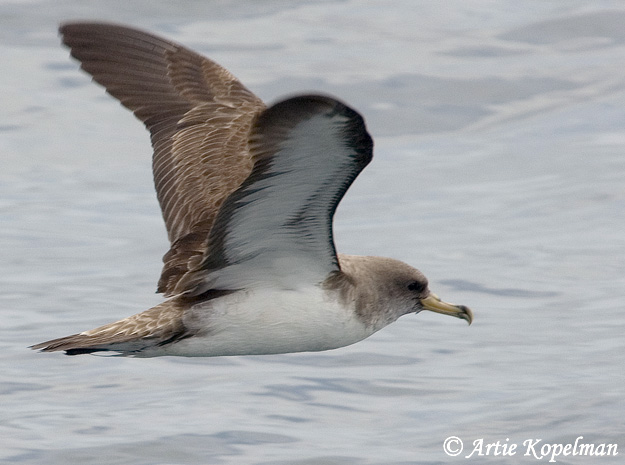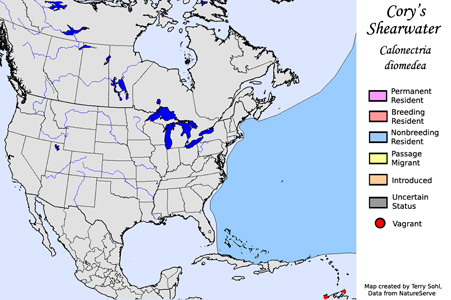| Length: 18 inches | Wingspan: 44 inches | Seasonality: Non-resident in South Dakota |
| ID Keys: White underside, dark upperparts, white under wings with dark edging, thick yellow bill | ||
 Cory's
Shearwater is a large Shearwater species of the Atlantic. They breed
in the Mediterranean and on islands in the eastern Pacific, but wander
widely after the breeding season. In North America, they are most
often seen off the East Coast in summer or early fall. It is thought
that most birds seen off North America are likely juveniles or non-breeding
adults. They tend to prefer areas with relatively warmer waters, and
thus in North American waters, are often seen in and around the Gulf Stream.
Cory's
Shearwater is a large Shearwater species of the Atlantic. They breed
in the Mediterranean and on islands in the eastern Pacific, but wander
widely after the breeding season. In North America, they are most
often seen off the East Coast in summer or early fall. It is thought
that most birds seen off North America are likely juveniles or non-breeding
adults. They tend to prefer areas with relatively warmer waters, and
thus in North American waters, are often seen in and around the Gulf Stream.
Habitat: Nests on islands with suitable nesting habitat, either islands with soil suitable for digging burrows, or rocky islands with crevices for nesting. Outside of the breeding season, they disperse widely in the Atlantic, usually over warmer water areas or areas with upwelling currents.
Diet: Feeds mostly on fish, squid, and small crustaceans.
Behavior: Forages by flying above the water's surface, and plunge diving from near the water's surface. They will also swim on the water's surface and grab items with their bill. They will also follow fishing boats for discarded scraps.
Nesting: Colonial breeder. Nests are usually burrows in the ground, but they will also sometimes use crevices in rocky areas, or nest on the ground in thickly vegetated areas. The nest itself is a basic pile of shells, pebbles, and other debris. The female lays a single egg, and both parents help to incubate it. Upon hatching, both parents help to feed and raise the nestling.
Song: Usually silent
Migration: Cory's Shearwaters breed in the Mediterranean, as well as islands in the eastern Atlantic. In North America, most birds are immatures and non-breeding birds, and are seen in the summer months through early fall.
Interactive eBird Map: Click here to access an interactive eBird map of Cory's Shearwater sightings
Similar Species: Most likely to be confused with Great Shearwater in range. The two species are similar in size, with light coloring below and dark coloring above, but Cory's Shearwaters have a much "cleaner" look on the underwing, with white and a dark border. Cory's Shearwaters also have a thick yellow bill, vs. the thin black bill of a Great Shearwater.
Conservation Status: Populations of Cory's Shearwater may be decreasing, but they still are found over a wide range and have strong populations overall. The IUCN lists the Cory's Shearwater as a species of "Least Concern".
Further Information: 1) BirdLife International - Cory's Shearwater
2) Audubon Guide - Cory's Shearwater
3) WhatBird - Cory's Shearwater
Photo Information: Photo taken by Artie Kopelman - Photo licensed under Creative Commons Attribution NonCommercial 2.0 Generic license.
| Click below for a higher-resolution map |
 |
| South Dakota Status: Non-resident in South Dakota |
Additional Cory's Shearwater Photos (coming soon!!)
